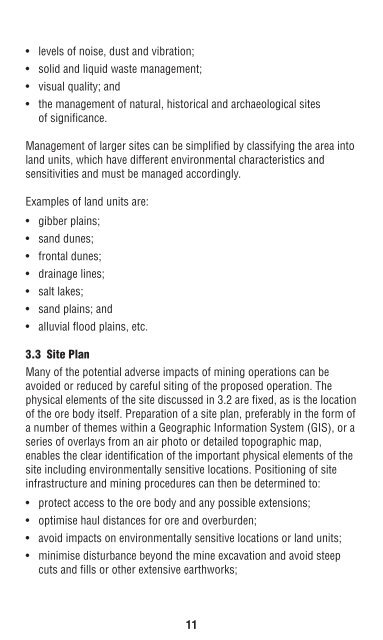Mine Rehabilitation Handbook - Mining and Blasting
Mine Rehabilitation Handbook - Mining and Blasting
Mine Rehabilitation Handbook - Mining and Blasting
Create successful ePaper yourself
Turn your PDF publications into a flip-book with our unique Google optimized e-Paper software.
• levels of noise, dust <strong>and</strong> vibration;<br />
• solid <strong>and</strong> liquid waste management;<br />
• visual quality; <strong>and</strong><br />
• the management of natural, historical <strong>and</strong> archaeological sites<br />
of significance.<br />
Management of larger sites can be simplified by classifying the area into<br />
l<strong>and</strong> units, which have different environmental characteristics <strong>and</strong><br />
sensitivities <strong>and</strong> must be managed accordingly.<br />
Examples of l<strong>and</strong> units are:<br />
• gibber plains;<br />
• s<strong>and</strong> dunes;<br />
• frontal dunes;<br />
• drainage lines;<br />
• salt lakes;<br />
• s<strong>and</strong> plains; <strong>and</strong><br />
• alluvial flood plains, etc.<br />
3.3 Site Plan<br />
Many of the potential adverse impacts of mining operations can be<br />
avoided or reduced by careful siting of the proposed operation. The<br />
physical elements of the site discussed in 3.2 are fixed, as is the location<br />
of the ore body itself. Preparation of a site plan, preferably in the form of<br />
a number of themes within a Geographic Information System (GIS), or a<br />
series of overlays from an air photo or detailed topographic map,<br />
enables the clear identification of the important physical elements of the<br />
site including environmentally sensitive locations. Positioning of site<br />
infrastructure <strong>and</strong> mining procedures can then be determined to:<br />
• protect access to the ore body <strong>and</strong> any possible extensions;<br />
• optimise haul distances for ore <strong>and</strong> overburden;<br />
• avoid impacts on environmentally sensitive locations or l<strong>and</strong> units;<br />
• minimise disturbance beyond the mine excavation <strong>and</strong> avoid steep<br />
cuts <strong>and</strong> fills or other extensive earthworks;<br />
11<br />
• minimise the noise <strong>and</strong> visual impacts (including lights) on adjacent<br />
l<strong>and</strong> users;<br />
• develop a site drainage plan; <strong>and</strong><br />
• optimise the configuration of the mined areas to accommodate the<br />
proposed post-mining l<strong>and</strong>-use.<br />
In areas where the potential for visual <strong>and</strong> noise impacts is large,<br />
provision to reduce impacts <strong>and</strong> remedial works can be incorporated<br />
into the site plan. Some examples of site planning are illustrated in<br />
Figure 3.1 below.<br />
A. Location of Access Roads - DIAGRAMS<br />
(a)<br />
Not Recommended<br />
(b) (c)<br />
Recommended<br />
12
















